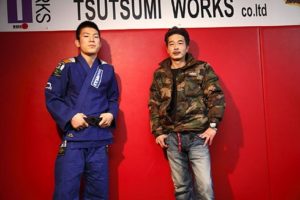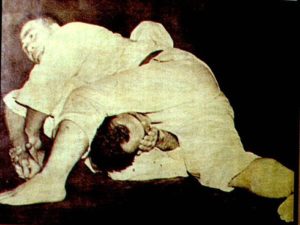This is a translation of an online article from March 23, 2010. The online article was featured in a magazine “Gonngu Kakutougi”
 April 17th Shinya Aoki will make his debut in the cage for the Strikeforce championship belt in the United States. Bringing Judo to a bloom in MMA, Aoki finished his opponent with the Kimura lock in the fight promotion Dynamite!! Masuda Toshinari, who was watching ringside is the writer for our magazine series, “Kimura Masahiko.” In this months edition, we draw close to the truth behind the Kimura vs Helio Gracie fight. We ask these two, who lead in the development of MMA, who is “Kimura?”
April 17th Shinya Aoki will make his debut in the cage for the Strikeforce championship belt in the United States. Bringing Judo to a bloom in MMA, Aoki finished his opponent with the Kimura lock in the fight promotion Dynamite!! Masuda Toshinari, who was watching ringside is the writer for our magazine series, “Kimura Masahiko.” In this months edition, we draw close to the truth behind the Kimura vs Helio Gracie fight. We ask these two, who lead in the development of MMA, who is “Kimura?”
Aoki: “Kimura Sensei was kinda wild and crazy don’t you think (lol)?”
"The sacred script comes from legendary Judo-ka, Kimura Masahiko" This was the introduction for Shinya Aoki, while watching a video on Kimura, the night before Dream light weight GP Championship Tournament. All men need to see this. He states, "Judo is not just a 'game', it's 'hand to hand combat.'" Masuda Toshinari, the author of "Why didn't Kimura Masahiko kill Rikidozan," is featured as a series in our magazine. Masuda was a fellow teammate to Aoki's instructor, Yuki Nakai in Nana Tei Judo ❶, a ground submission style resembling Kosen Judo❷, while they were attending Hokkaido University. At the New Year's Eve bashing of Aoki, a blog was immediately released in his defense. "There's no choice but to break it if the tap doesn't happen. In Nana-Tei, arguments always ensue when a submission is stopped preemptively by the referee." Masuda feels "a writer needs to take a stand to protect the powerless individual, especially when a 'society vs individual' type of situation arises. Just as in the story of Kimura Masahiko, historical examples are utilized to restore honor to Kimura while explaining Judo as a combat art. Judo and MMA... Within those contrasting sports exists the genes of Kimura Masahiko, and the ideal material when thinking about the meaning of combat arts. 59 years ago, Kimura crossed the seas to face Helio Gracie. This spring, Aoki joins Strikeforce to make his in the cage debut in the United States. We dove into understanding their roots with this special discussion at DEEP Dojo.
Masuda: We’ve met at a few fights, but this is the first time we’re face to face like this. What impressions do you have of Kimura Masahiko Sensei?
Aoki: Kinda wild and crazy don’t you think (lol)? With what he does and stuff.
Masuda: To be honest there are a lot of mischief and bad boy stories I can’t write of Kimura Sensei (lol). But, personally speaking, those are the things I like about him (lol).
Aoki: In my opinion, Kimura Masahiko is so different from everyone that, how do you put it, there’s some good stories (lol). Just like the wrestler, Hatta Ichiro❸.
Masuda: I think to be the super elite you need to be that different.
Aoki: Ya, but I also think there’s a lot of useless stuff being done as well. Like all the abnormal training. It’s hard to measure the intensity of their practices too. You know how Kosen Judo had that kinda thing.
Masuda: Kosen Judo is definitely known for their quantity of training, but there is definitely a possibility for time to be wasted when increasing the sparring load for ground submissions.
Aoki: I read somewhere that they wiped up their sweat with a zookin❹ or something.
Masuda: In the case of Judo, I think there’s an element of satisfaction in simply getting tired after increasing workload. Even among the power house universities in Tokyo. That’s why increasing the duration of training can be problematic if the intensity decreases. I think present day Judo needs to learn the more scientific approach of Brazilian Jiu Jitsu and MMA. I believe this is a big problem within sports in Japan. That practices are conducted in large groups. Thinking about training intensity is an element that distinguishes you as a super top fighter like yourself, Aoki.
Masuda: “Aoki, You’re you’re quite the Kimura maniac aren’t you”

Aoki: I often hear that Judo players from the good ole days were really good. I wonder if Okano Isao❺ Sensei really was the best of post war era Judo players? What would it be like going against players from this day and age? If we simply look at just their conditioning, present day Judo players would probably be ahead.
Masuda: What’s certain is that there is no way for us to prove anything. But in the case of Kimura Sensei, he would go around to drop into other dojo’s on his own. So I think he must have had a similar notion of “training intensity” as you Mr. Aoki. In my writing, I’ve noted that he intentionally sought out circumstances where he was surrounded by his enemies because the training rounds would be wasted when simply training at his university. I’ve interview many people, but Kimura Sensei would start with quantity to increase the quality and I believe the intensity of his practices were quite high. He also stressed the importance of research. I think he was a person who thought much like you Mr. Aoki. I think everyone eventually comes to the same conclusion to get to the top. You’ve seen video of Kimura Sensei right?
Aoki: Yes. That Oosoto Gari right? Competitors would tell him, “Kimura, anything but that Oosoto Gari, please.” That’s just too embarrassing to ask or even write in your autobiography. That’s what I think is impressive. I saw the video of Katou (Yukio) vs Helio❻ fight too, but it’s surprising to see them wearing a gi while standing in the ring. And in many ways there is a sense of nostalgia and romanticism about it. I’m simple and I also like that kind of spectator type martial arts. There’s also the story that Kimura Sensei used to grip the gi with all five fingers, which has left on an impact on me. Judo players these days don’t typically grip the gi with all five fingers, when Kimura Sensei was asked about it he answered, “Because with 5 fingers your stronger.” You begin to wonder, how strong is this guy?!? (lol).
Masuda: Oh ya, especially the guys from Tenri University❼, they tend to grip hard. They say all you need to do is to hook the gi with the fingertips because it prevents the wrist from rotating.
Aoki: Kimura Masahiko….. He’s definitely a different guy (lol). When practice gets tough I sometimes say to myself, “If I were Kimura Sensei,” and I get a little different myself. “Kimura Sensei would be fine!” like that. I also like the story I read in his autobiography where he showed up to a drinking bar with a bag of rice instead of money insisting, “I am Kimura Masahiko. Let me drink sake in exchange for this.” (lol)
Masuda: You know quite a bit (lol).
Aoki: I know a hell of a lot. Like the time miso soup turned out to be crap soup.
Masuda: Hahaha. Mr. Aoki you’re quite the Kimura maniac (lol). Do you know the story, right around the time Iwatsuri Kaneo❽ Sensei enrolled in school, where the Takushoku University Judo Club were eating dog stew?
Aoki: Speaking of Iwatsuri Sensei, there’s a bunch of stories like the time he walked over a Mercedes Benz while wearing geta❾ (lol). He has that Takushoku University pedigree where they all have their own strong personalities. They all just kinda different from everyone else.
Masuda: Do you have any recollections like that from the time you were a Judo athlete?
Aoki: Everyone says so, but the one’s who did it never remember. People say, “Aoki was horrible,” when talking about stories from back in the day, but I don’t have a single recollection of beating anyone up during practice (lol).
Masuda: I heard this from your Kohai⑩. He said you choked him unconscious 6 or 7 times every time you practiced (lol)….. The rest continued in “Gongu Kakutougi” May edition.
Profile: Toshinari Masuda Born in 1965. Attended the University of Hokkaido. As a member of the University of Hokkaido Judo Club, experiences Nana Tei Judo, a newaza centered style similar to Kosen Judo. Yuki Nakai joined the Judo Club 3 years after him. In 2006, "Shatoon Higuma no Mori" (Takarajima Co. Masuda Toshinari) won the "Kono Misuteri ga Sugoi," Grand Excellence Prize. A series in "Gekkan Hiden" recounts the daily Judo practices and Univeristy of Hokkaido titled, "Nana Tei Judo Ki." A series of our own "Kimura Masahiko wa Naze Rikidouzan wo korosanakatta noka" has become a topic of interest among book reviews.
❶ Nana Tei Judo: A ground submission based Judo practiced at the seven public schools established in 1886; Hokkaido Univ, Tohoku Univ, Tokyo Univ, Nagoya Univ, Kyoto Univ, Osaka Univ, Kyushu Univ.
❷ Kosen Judo: Originated in 1898, similar to Judo but with different rules an emphasis on ground submission where competitors could drop to their guard and winning was determined by submissions.
❸ Hatta Ichiro: 1906-1983. A Japanese wrestler and politician famous for his spartan like training and coaching regimen.
❹ Zookin: Rag used to mop and clean the floor or walls.
❺ Okano Isao: 1944~. Judo Olympic gold medalist.
❻ Katou (Yukio) vs Helio: The first match, a Brazilian Jiu Jitsu rule 3x10min round match ended in a draw. In the second match a few weeks later, Helio won by choke at minute 8.
❼ Tenri University: A private university in Nara prefecture, with a deep tradition for Judo.
❽ Iwatsuri Kaneo: 1944-2011. 7th degree Judo master. One of Kimura’s best disciples.
❾ Geta: Traditional Japanese sandal made from wood. 
⑩ Kohai: The junior member of a group. In Japan and especially in martial arts the sempai (senior member of a group) are expected to mentor and look after the kohai’s in the group.